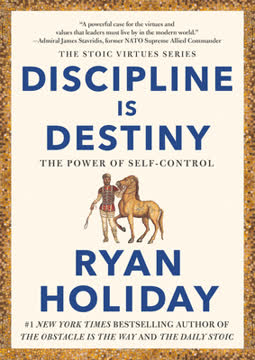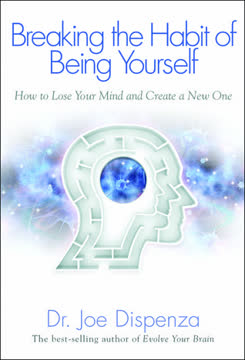Key Takeaways
1. The Quantum You: Your Thoughts Shape Your Reality
"When we are mired in the past, however, none of those new potentials exist."
Your mind shapes reality. Quantum physics reveals that our thoughts and feelings have a direct impact on the world around us. The observer effect in quantum mechanics demonstrates that the act of observation affects the observed reality. This principle extends to our daily lives, where our thoughts and emotions influence our experiences and outcomes.
Coherent thoughts create coherent realities. Just as waves in a signal are more powerful when they are in phase, our thoughts and feelings are most effective when aligned. When we think and feel in harmony, we broadcast a stronger electromagnetic signal that attracts potential realities matching our desires.
- Key aspects of quantum reality:
- Everything is energy and information
- We are connected to a vast field of possibilities
- Our observations collapse waves of probability into physical reality
- Coherent thoughts and emotions are more powerful than scattered ones
2. Overcoming Your Environment: Breaking Free from External Influences
"To change, then, is to think and act greater than our present circumstances, greater than our environment."
Environment shapes identity. Our surroundings, including people, places, and things, significantly influence our thoughts, feelings, and behaviors. This external world often keeps us stuck in familiar patterns, reinforcing our current identity and limiting our potential for change.
Breaking free requires conscious effort. To overcome environmental influences, we must become aware of how our surroundings affect us and make deliberate choices to think and act differently. This involves:
- Recognizing habitual responses to environmental cues
- Cultivating self-awareness and metacognition
- Creating new neural pathways through mental rehearsal
- Choosing thoughts and actions aligned with our desired self
- Persisting in new behaviors despite environmental resistance
By consistently thinking and acting beyond our current circumstances, we can break free from the limitations imposed by our environment and create a new reality aligned with our true potential.
3. Mastering Your Body: Unlearning Emotional Addictions
"When the body has become the mind, that's called a habit."
Emotional addictions shape our identity. Our bodies become conditioned to certain emotional states, creating a biochemical addiction that reinforces our current personality. These emotional habits often stem from past experiences and can keep us stuck in unproductive patterns.
Unlearning requires awareness and effort. To break free from emotional addictions, we must:
- Recognize our habitual emotional states
- Understand the thoughts and behaviors associated with these emotions
- Consciously choose new emotional responses
- Practice new thoughts and behaviors consistently
- Allow the body to adapt to new emotional states
- Key steps in mastering the body:
- Identify dominant emotions
- Observe associated thoughts and behaviors
- Choose alternative emotional responses
- Practice new mental and physical habits
- Persist through withdrawal symptoms
By consciously changing our emotional patterns, we can rewire our brains and bodies, creating a new baseline state of being that supports our desired identity and reality.
4. Transcending Time: Living in the Present Moment
"To forget about the people we know, the problems we have, the things we own, and the places we go; to lose track of time; to go beyond the body and its need to feed its habituations; to detach from trying to predict a future condition or review a past memory; to lay down the selfish ego that is only concerned with its needs; to think or dream greater than how we feel, and crave the unknown—this is the beginning of freedom from our present lives."
Time constrains our potential. Our preoccupation with past experiences and future anxieties keeps us trapped in a limited version of ourselves. This focus on time prevents us from fully engaging with the present moment and accessing our true potential.
Transcending time opens new possibilities. By learning to live in the present moment, we can:
- Break free from past conditioning and future worries
- Access the quantum field of infinite possibilities
- Align our thoughts and feelings with our desired reality
- Create from a state of pure consciousness
Techniques for transcending time:
- Mindfulness meditation
- Focused attention on the present moment
- Letting go of past regrets and future anxieties
- Cultivating a state of timelessness during creative activities
- Practicing being fully present in daily activities
5. From Survival to Creation: Shifting Your State of Being
"Living in survival is the reason why we humans are so dominated by the Big Three."
Survival mode limits our potential. When we operate from a state of stress and fear, we become fixated on our environment, our bodies, and time. This survival-oriented mindset keeps us trapped in familiar patterns and prevents us from accessing our creative potential.
Shifting to creation mode unlocks new possibilities. By consciously moving from survival to creation, we can:
- Release limiting emotions and thoughts
- Access higher states of consciousness
- Tap into our innate creative abilities
- Align with the universal intelligence that governs all things
Steps to shift from survival to creation:
- Recognize when you're in survival mode
- Practice relaxation techniques to calm the nervous system
- Cultivate positive emotions like love, joy, and gratitude
- Focus on possibilities rather than problems
- Engage in creative activities that bring you into a flow state
- Regularly connect with your higher purpose and vision
By making this shift, we can move beyond our limited, ego-driven self and become co-creators of our reality, working in harmony with the universal intelligence that surrounds us.
6. The Three Brains: Thinking, Doing, and Being
"When you can think, act, and feel differently whenever you choose, you have become the master."
Three brains facilitate change. The neocortex (thinking brain), limbic brain (emotional brain), and cerebellum (doing brain) work together to create lasting change in our lives. Understanding and leveraging these three brains allows us to transform our thoughts, behaviors, and emotional states.
The progression of change:
-
Thinking (Neocortex):
- Acquiring new knowledge
- Contemplating possibilities
- Challenging existing beliefs
-
Doing (Limbic Brain):
- Applying new knowledge
- Creating new experiences
- Generating new emotions
-
Being (Cerebellum):
- Internalizing new states
- Automating new behaviors
- Embodying new identity
By consciously engaging all three brains, we can:
- Create lasting neural changes
- Develop new habits and skills
- Transform our emotional baseline
- Embody our desired state of being
The key is to align our thoughts, actions, and feelings, creating a coherent state that becomes our new normal. This integration of the three brains allows us to truly become the masters of our own transformation.
7. Meditation: The Gateway to Personal Transformation
"To meditate means 'to become familiar with.'"
Meditation is a powerful tool for change. It allows us to access our subconscious mind, rewire neural pathways, and create new states of being. Through regular practice, we can overcome limiting beliefs, emotions, and behaviors, paving the way for personal transformation.
Key aspects of effective meditation:
- Induction: Entering a relaxed, receptive state
- Focus: Directing attention to specific thoughts or sensations
- Repetition: Consistently reinforcing new neural patterns
- Visualization: Mentally rehearsing desired outcomes
- Emotional engagement: Feeling the reality of the new state
Benefits of regular meditation practice:
- Increased self-awareness
- Enhanced emotional regulation
- Improved focus and concentration
- Greater access to intuition and creativity
- Reduced stress and anxiety
- Heightened sense of well-being and connection
By making meditation a daily habit, we can systematically reprogram our minds and bodies, aligning them with our desired reality and unlocking our full potential for growth and transformation.
8. Recognizing and Dismantling the Old Self
"Only when you are truly conscious and aware do you begin to wake up from the dream."
Self-awareness is crucial for change. To transform ourselves, we must first become acutely aware of our current thoughts, emotions, and behaviors. This recognition allows us to identify the aspects of our old self that no longer serve us and begin the process of dismantling them.
Steps to recognize and dismantle the old self:
-
Self-observation:
- Monitor your thoughts, feelings, and actions
- Identify recurring patterns and triggers
-
Honest assessment:
- Acknowledge limiting beliefs and behaviors
- Recognize emotional addictions and habits
-
Letting go:
- Release attachment to old identities
- Surrender limiting emotions to a higher power
-
Redirection:
- Interrupt old patterns as they arise
- Consciously choose new responses
By consistently practicing these steps, we can:
- Increase our conscious awareness
- Break free from automatic reactions
- Create space for new ways of being
- Align our actions with our desired self
The process of recognizing and dismantling the old self is ongoing, requiring patience, persistence, and compassion. As we continue this practice, we gradually free ourselves from the limitations of our past and open up to new possibilities for growth and transformation.
9. Creating Your New Mind and Future Self
"Your new personality should produce a new reality."
Consciously create your new self. After dismantling the old self, we must actively engage in creating our new identity. This involves mentally rehearsing new thoughts, emotions, and behaviors that align with our desired future reality.
Key steps in creating your new mind:
-
Visualization:
- Clearly imagine your ideal self and life
- Engage all senses in this mental rehearsal
-
Emotional engagement:
- Generate and amplify positive emotions
- Feel as if your desired reality is already present
-
Repetition:
- Consistently practice new thought patterns
- Reinforce new neural pathways through repetition
-
Identity shift:
- Embody the qualities of your new self
- Act "as if" you are already living your desired reality
-
Quantum creation:
- From this new state, envision specific future events
- Trust in the universal intelligence to manifest your desires
By consistently practicing these steps, we can:
- Rewire our brains for new patterns of thinking and feeling
- Condition our bodies to new emotional states
- Align our energy with our desired future reality
- Attract experiences that match our new state of being
Remember that creating your new mind is an ongoing process. Stay committed to your vision, remain open to unexpected opportunities, and trust in the universal intelligence to guide you toward your new reality.
10. Living Your New Reality: Demonstrating and Being Transparent
"When how you appear is who you are, you are free from the enslavement of your past."
Embody your new self consistently. The final step in personal transformation is to live as your new self in every moment. This means aligning your thoughts, feelings, and actions with your desired reality, regardless of external circumstances.
Keys to demonstrating your new reality:
-
Consistency:
- Maintain your new state of being throughout the day
- Respond to challenges from your new perspective
-
Faith:
- Trust in the process of change
- Believe in the reality of your new self
-
Detachment:
- Release attachment to specific outcomes
- Remain open to unexpected manifestations
-
Gratitude:
- Appreciate signs of change, no matter how small
- Cultivate a sense of joy and thankfulness
-
Transparency:
- Allow your inner transformation to shine through
- Be authentic in your interactions with others
By living your new reality:
- You reinforce neural pathways of your new self
- You attract experiences that match your new energy
- You inspire others through your transformation
- You create a positive feedback loop of growth and change
Remember that transformation is an ongoing journey. Embrace the process, celebrate your progress, and remain committed to your vision of your highest self. As you consistently demonstrate your new reality, you will find that your external world begins to reflect the inner changes you've made, creating a life that aligns with your truest desires and potential.
Last updated:
FAQ
What's Breaking the Habit of Being Yourself by Joe Dispenza about?
- Transforming Mindset: The book focuses on changing thoughts and feelings to create a new reality, combining neuroscience, quantum physics, and spirituality.
- Practical Techniques: It offers meditation techniques and exercises to help break old habits and create a new self, empowering individuals to control their lives.
- Mind-Body Connection: Emphasizes how thoughts influence physical health and emotional well-being, illustrating the connection between mind and body.
Why should I read Breaking the Habit of Being Yourself by Joe Dispenza?
- Empowerment Through Knowledge: Offers insights into brain functions for personal transformation, empowering readers to manage mental and emotional states.
- Scientific Basis: Grounded in scientific research, it makes complex concepts accessible, explaining how neuroscience discoveries apply to daily life.
- Practical Application: Provides actionable steps for self-improvement and personal growth, making it a practical guide for readers.
What are the key takeaways of Breaking the Habit of Being Yourself by Joe Dispenza?
- Change is Possible: Asserts that changing thoughts and feelings can change one's life, emphasizing that the past doesn't dictate the future.
- Meditation as a Tool: Presents meditation as a powerful tool for rewiring the brain and creating new emotional states, with specific techniques outlined.
- Quantum Reality: Introduces the quantum field concept, explaining how accessing it can help create desired realities.
What are the best quotes from Breaking the Habit of Being Yourself by Joe Dispenza and what do they mean?
- “The greatest habit you can ever break is the habit of being yourself.”: Central theme of transformation, suggesting letting go of old identity to create a new life.
- “What you think today determines how you live tomorrow.”: Highlights the power of thoughts in shaping the future, emphasizing conscious thinking.
- “You are more than your past.”: Encourages recognizing potential for change, reinforcing that past experiences don't define who we are or can become.
How does Dr. Joe Dispenza define the process of change in Breaking the Habit of Being Yourself?
- Three Steps to Change: Outlines a process of thinking, doing, and being, moving from understanding to application and a new state of being.
- Neuroplasticity: Discusses the brain's ability to rewire through new experiences and thoughts, crucial for understanding change.
- Emotional Conditioning: Emphasizes the role of emotional states in change, conditioning the body to feel new emotions for a new identity.
What meditation techniques are recommended in Breaking the Habit of Being Yourself by Joe Dispenza?
- Guided Meditations: Provides specific meditations to access the quantum field and create new emotional states, facilitating deep inner work.
- Body Awareness: Focuses on different body parts to enhance awareness and connection, attuning to physical sensations and emotional responses.
- Visualization: Encourages visualizing desired outcomes to condition the mind and body, embodying the experience emotionally.
How does the concept of the quantum field relate to personal transformation in Breaking the Habit of Being Yourself?
- All Possibilities Exist: Explains that the quantum field contains all potential realities, allowing individuals to choose which to manifest.
- Observer Effect: Discusses how observation influences reality, illustrating how thoughts and intentions shape experiences.
- Creating New Realities: Aligning thoughts and feelings with desired outcomes collapses potential into tangible experiences, central to empowerment and transformation.
What role does the body play in the process of change according to Breaking the Habit of Being Yourself by Joe Dispenza?
- Body as the Mind: Emphasizes that the body memorizes emotional states and reactions, leading to automatic behaviors hindering growth.
- Chemical Responses: Explains how thoughts trigger chemical responses, reinforcing emotional states, key to breaking old habits.
- Conditioning the Body: To change, condition the body to feel new emotions aligning with desired identity, rewiring brain and body.
How can I apply the principles from Breaking the Habit of Being Yourself by Joe Dispenza in my daily life?
- Daily Meditation Practice: Incorporate recommended techniques into daily routine to facilitate change, reinforcing new neural pathways.
- Self-Reflection: Engage in self-reflection to identify limiting beliefs and patterns, consciously choosing new thoughts and feelings.
- Set Intentions: Define intentions for change and visualize desired outcomes, aligning thoughts and feelings with goals.
What’s Meditations for Breaking the Habit of Being Yourself by Joe Dispenza about?
- Core Concept: Explores the connection between thoughts, emotions, and personal reality, emphasizing changing thoughts and feelings to change life.
- Meditation Focus: Provides a structured approach to meditation for self-transformation, guiding readers to create a new identity.
- Quantum Perspective: Integrates quantum physics principles, suggesting thoughts and emotions influence reality, empowering control over life.
What is the meditation process outlined in Meditations for Breaking the Habit of Being Yourself by Joe Dispenza?
- Induction: Techniques to transition from high Beta to relaxed Alpha brain-wave state, preparing for deeper meditation.
- Recognizing and Admitting: Guide to identify and acknowledge self-limiting emotions and thoughts, essential for breaking old habits.
- Creating and Rehearsing: Focus on visualizing and emotionally connecting with the new self, rehearsing identity to solidify in subconscious.
How does Joe Dispenza define meditation in Meditations for Breaking the Habit of Being Yourself?
- Familiarity with Self: Defines meditation as becoming familiar with oneself, emphasizing self-observation and development.
- Accessing the Subconscious: Explains meditation allows bypassing the analytical mind to access subconscious beliefs and habits.
- Creating Change: Ultimate goal is to reprogram mind and body to align with a new identity and reality.
Review Summary
Meditations for Breaking the Habit of Being Yourself receives mixed reviews, with an overall positive reception. Many readers find it transformative and life-changing, praising its scientific approach to meditation and personal growth. Some appreciate the guided meditations, while others find them time-consuming or challenging. Critics point out issues with the audiobook format and question some of the book's scientific claims. Despite these concerns, many readers report feeling changed by the book's teachings and find value in its practical applications for personal development.
Similar Books
Download PDF
Download EPUB
.epub digital book format is ideal for reading ebooks on phones, tablets, and e-readers.















